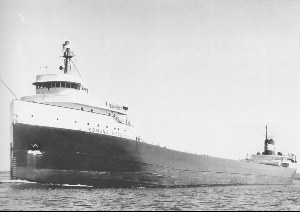
The Edmund Fitzgerald was the largest ship that ever sank in the Great Lakes, and one of the most famous shipwrecks in the world. Many of the details about its sinking remain unknown.
At 2:30 pm, on November 9th, 1975, the Edmund Fitzgerald departed from Superior, Wisconsin. Its captain was Ernst M. McSorley, along with 28 other crew members, and 26,116 tons of cargo.
Soon after it departed, it was joined by a ship called the Arthur M. Anderson, and its captain, Bernie Cooper. The two ships were on the same course and remained 10 to 15 miles away from each other.
Storm warnings had been issued at about 7:00 pm the day before. By the early afternoon, the two ships had passed Michipicoten Island and were approaching Caribou Island. Captain Cooper reported watching the Fitzgerald go over Six Fathom Shoal, which is dangerous to big ships, because of how shallow it is.
A little while after that, the wind started to pick up and the Anderson lost sight of the Fitzgerald in the spray. At about 3:30 pm, the Fitzgerald radioed: "Anderson, this is Fitzgerald, I have a fence rail down, two vents lost or damaged, and a list. Will you stay with me till I get to Whitefish?" (Whitefish Point was the closest pier to their current location). Into the afternoon, the two ships radioed each other with navigational information, but nothing unusual, or alarming.
After a few hours, the Anderson started losing sight of the Fitzgerald for short periods of time on the radar because of increasingly high seas. The last time the Anderon contacted the Fitzgerald was at about 7:10 pm. The two ships exchanged navigational information again and Captain Cooper asked about the Fitzgerald's condition. The Fitzgerald continued to go on and off the radar, until about 7:15 pm, when it went off the radar for good. The Anderson tried to radio the Fitzgerald but received no response.
At this time, the weather had started to clear. The Anderson radioed other ships in the area, asking if any of them had seen or heard from the Fitzgerald. Then they radioed the Coast Guard, asking for help. The Coast Guard set out around 8:00 pm.
The Coast Guard asked the Anderson if they could turn around and help search for the Fitzgerald, and Captain Cooper reluctantly agreed. After an hour, the Anderson found two of the Fitzgerald's lifeboats, and other debris from the ship, but no sign of the wreck, and no survivors or bodies.
At about 10:00 pm, the Coast Guard launched a plane to help in the search, after searching with boats didn't provide any new information. They searched throughout the night but never found any sign of the wreck or any bodies.
The next day, a military plane flew over the area, with a magnetic anomaly detector, and located the wreck. A few months later a search party took a full scan of the wreck, and over 850 photos were taken, but they never found any bodies.
The cause of the sinking was never found, but the two main theories are that the boat flooded, or that the waves caused it to split in half, because of its narrow center. It is still a mystery what happened to the crew. The Edmund Fitzgerald remains one of the most famous shipwrecks in the Great Lakes, and maybe even the world.
[Source:
Great Lakes Shipwreck Museum
]

